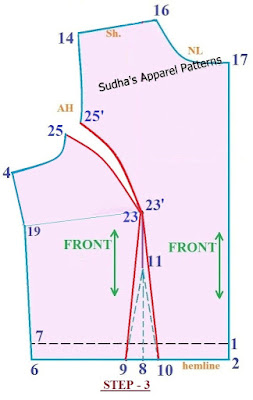Shirt style Blouse can be combined with Skirt, Trousers or Jeans. Since this style of blouse has collar and hem shaping as shirt, it is called as the Shirt style Blouse.
In this post I have shown stepwise pattern making of Shirt style Blouse. This Blouse will have a basic Sleeve, Shirt collar pattern with rounded corners and will be till hip length. You can always do a variation in the sleeve length. This style of blouse will have side seam oblique dart in front and waist darts in both front and back.
In this post I have shown stepwise pattern making of Shirt style Blouse. This Blouse will have a basic Sleeve, Shirt collar pattern with rounded corners and will be till hip length. You can always do a variation in the sleeve length. This style of blouse will have side seam oblique dart in front and waist darts in both front and back.
* The pictures and instructions are offered here for free. Please don't repost any of my content without permission. Thanks!
To make a Shirt style Blouse, all measurements must be taken with great care for precise results.
Some Tip:- It is very important that you wear your best fit under garment (i.e. Bra) in order to get the most accurate measurements. If you think the bra is loose, adjust the straps accordingly, before taking blouse measurements.
You can wear a padded bra, though its optional.
Measurements required (in centimetres)
1. Length of blouse (till hip) - Measure from the centre of the front shoulder passing over the bust point to hipline. *Length of this blouse style is till hips.
2. Length till Waist - Measure from the centre of the front shoulder passing over the bust point to the waistline.
3. Round Neck - Measure around the neck touching front collar bone moderately tight.
3. Round Neck - Measure around the neck touching front collar bone moderately tight.
4. Round Bust - Measure around the body at the fullest point of bust. Do not allow the measure tape to fall at back. The tape should pass on the most protruding part of bust.
5. Round Waist - Measure around the body and below the bust.
6. Shoulder - Measure from back neck bone to shoulder bone.
7. Sleeve length - Measure the length by keeping the measure tape from neck over shoulder till the fullest part of arm.
8. Round Arm - Measure around the fullest part of the arm which is between the shoulder and the elbow.
8. Round Arm - Measure around the fullest part of the arm which is between the shoulder and the elbow.
Steps of Drafting
0-1 = Length of Blouse + 1 cm
1-2 = down by 2 cms
0-3 = towards left by 2 cms
3-4 = draw straight line down till 1
3-5 = 1/5 Round Bust + 1 cm
3-6 = Length till Waist + 1 cm
5-7 = 1/4 Round Bust + 1 cm
7-8 & 2-8 = Join points by drawing lines
1-9 = draw parallel line to 2-8
6-10 = draw horizontal line
10-11 = towards right by 2 cms
9-12 = 1/10 Round Bust
12-13 = towards right by 2 cms
Waist dart:-
6-14 = 1/10 Round Bust - 1 cm
14-15 = 2 cms (dart width)
15-16 = Midpoint of 14-15
16-17 & 16-18 = 1/8 Round Bust (dart length)
Join 14-18-15-17 & 17-16-18 to form a dart
Side seam dart:-
11-19 = 1/16 Round Bust
19-20 = 2 cms (dart width)
20-21 = Midpoint of 19-20
21-22 = 1/8 Round Bust + 2cms (dart length)
Join 19-22-20 & 21-22 to form a dart
3-23 Shoulder + 0.5 cm
23-24 = draw straight line down
23-25 = down by 2.5 cms
24-26 = up by 3 cms
3-27 = 1/5 Round Neck - 1 cm
0-28 = 1/5 Round Neck - 1 cm
Join 28-27 (front neck)
27-25 (front shoulder)
25-26-7 (front armhole)
7-11-12-13 (front side seam)
13-2 (front shaped hemline)
BACK
3-29 = down by 1 cm (for back neck curve)
27-30 = up by 2 cms
25-31 = up by 2 cms
26-32 = 1.5 cms (for back armhole curve)
Join 29-30 (back neck)
30-31 (back shoulder)
31-32-7 (back armhole)
7-11-12-13 (back side seam)
13-4 (back shaped hemline)
Shirt Collar (with rounded corners)
1-2 = 5 cms
2-3 = 1/2 Round Neck + 0.5 cm
Join 3-4 & 0-4
3-5 = 3.5 cms
Join 5-6 & 1-6
4-7 = 5 cms
7-8 = down by 0.5 cm
5-9 = up by 2 cms
6-10 = towards right by 0.5 cm
4-11 = towards left by 3 cms
8-12 = Length of collar corner (i.e. 9 cms) + 1 cm
[*it's a slant line passing through 11]
[*it's a slant line passing through 11]
0-13 = Midpoint of 0-4
2-14 = up by 1 cm
3-15 = 1/3 of 2-3
1-16 = up by 0.5 cm
Join 16, 8, 12, 13, 0, 16 for Collar piece &
join 8, 10, 9, 15, 14, 16, 8 for Stand piece
join 8, 10, 9, 15, 14, 16, 8 for Stand piece
Basic Sleeve
1-2 = 3 cms (self folding hem)
0-3 = 1/5 Round Bust + 2 cms
Join 3-4 & 2-4
3-5 = 1/10 Round Bust + 1.5 cms
1-6 = 1/2 Round Arm + 2 cms
Join 6-7 & 2-7
Join 0-5 in slant line
Join 0-5 in slant line
0-8 = 1/4 of 0-5
5-9 = 1/4 of 0-5
9-10 = draw perpendicular of 2 cms downwards
8-11 = draw perpendicular of 2 cms upwards
5-12 = 2 cms
Join 0-11-12-5 (back curve)
0-8-10-12-5 (front curve)
5-6-7 (side seam)
Fabric used:- For making a Shirt style blouse, you can use thin Poplin, 2 x 2, Khadi, Cambric, Satin, Voile etc. However, if you are beginner, prefer using pure cotton fabric for making this style of blouse. Length of fabric should be 2.5 meters and width can be 36" (for Small / Medium size) & 44" / 48" (for Large / XL size).
You can also use different fabrics (i.e. plain, printed, embroidered etc) to get variations.
You can also use different fabrics (i.e. plain, printed, embroidered etc) to get variations.
Some Tips:- when preparing the fabric for draft placement & cutting:--
1) If using basic woven cotton material, then straighten the fabric by slightly stretching it diagonally to align the warp & weft at right angle.
2) Iron the fabric always to make it crease free prior to marking / placing the draft over it.
3) If you are a beginner, prefer making the draft on paper and then pin it to fabric.
*Once you are successful making a basic blouse you can do variations with different types of sleeves; try making with different fabrics like, printed/ embroidered/ checkered / striped etc. Do try and let me know in the comments box below. :)
I hope you liked this post of a simple blouse pattern.
If you liked it then Pin it!☺
If you enjoyed this post, please spread by emailing it to a friend, or sharing it on Pinterest, Twitter, Google+ or Facebook. Thank you!
Stay connected on
I love hearing from readers of my blog so please feel free to leave a comment and let me know what you thought about this or any other post/tutorial given in the blog. Any tips / hints to improve my articles are always much appreciated too!☺☺
Happy Sewing!




















